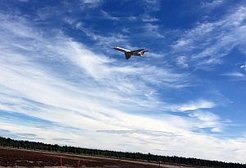Europe-wide research flights focus on greenhouse gas methane
The CoMET research mission measures the two most important greenhouse gases carbon dioxide (CO2) and methane (CH4) in the atmosphere. The specially equipped aircraft will examine the airspace from Europe to North Africa from mid-May to mid-June 2018. Led by the German Aerospace Center (Deutsche Zentrum für Luft- und Raumfahrt DLR), the mission is carried out in cooperation with the Max Planck Institute for Biogeochemistry, Jena, and the universities of Bremen and Heidelberg.

The HALO aircraft (High Altitude and Long Range Research Aircraft) takes off from its home base in Oberpfaffenhofen, near Munich, for its measurement flights at altitudes of around 8 to 15 kilometres. Equipped with seven instruments, it will target a range from Finland to North Africa to record greenhouse gases and other meteorological parameters and to collect specific air samples. At selected locations, additional spirals are flown close to the ground to obtain highly accurate information on the height distribution of greenhouse gases.
Methane – a powerful greenhouse gas
Carbon dioxide is widely known to be the most important greenhouse gas in the atmosphere caused by human activities. What is less well known is that despite the fact that its concentration in the atmosphere is 200 times lower than that of carbon dioxide, methane also has a major impact as a greenhouse gas. According to a report by the Intergovernmental Panel on Climate Change in 2013, over the first 20 years, the climatic effect of an emitted methane molecule is 86 times greater than that of a carbon dioxide molecule.
With the new aircraft measurements, methane in particular is to be recorded and the sources and sinks of greenhouse gases detected in detail. Methane emissions come from coal production, the oil and gas industry, landfills, livestock farming and rice cultivation. However, there are also natural springs such as wetlands or permafrost soils. The researchers have developed a number of forecasting models which predict where to expect higher concentrations of greenhouse gases under particular weather conditions. Flight planning is carried out on the basis of these models with the goal to optimize the measuring strategy and to effectively bridge data gaps across Europe.
Testing innovative instrumentation
The CoMet mission, initiated by DLR, the Max Planck Institute for Biogeochemistry and the Universities of Bremen and Heidelberg, will test several new instruments in addition to conventional measuring devices. A cavity ring-down spectrometer developed by the Max Planck Institute for Biogeochemistry in Jena is on board. "With this instrument, which we have adapted for the aircraft, we can continuously measure the most important greenhouse gases directly at the respective flight location," explains Dr. Christoph Gerbig, project manager in Jena. For the first time, an automatic sampling system also developed at the Max Planck Institute for Biogeochemistry collects air samples for subsequent laboratory analysis.
Project partners and funding
The scientific project partners are the German Aerospace Center (DLR), the Max Planck Institute for Biogeochemistry in Jena, the Universities of Bremen and Heidelberg, and the Free University of Berlin. In addition, research institutions from eight different countries are involved, together with international associations of monitoring networks and space agencies, all of which can benefit from this special flight mission. The CoMet research project is funded with approximately one million euro from the partner institutes and the German Research Foundation (Deutsche Forschungsgemeinschaft; DFG). In addition, the evaluation of the measurement results of the flight tests that are currently taking place, along with the further development and use of the instruments and models as part of the ‘Aircraft Remote Sensing of Greenhouse Gases with combined Passive and Active instruments’ (AIRSPACE) project, received funding of 3.9 million euro from the German Federal Ministry for Education and Research (Bundesministerium für Bildung und Forschung; BMBF).
About HALO
The HALO research aircraft is a joint initiative of German environmental and climate research institutions. HALO was procured with funds provided by the German Federal Ministry of Education and Research (BMBF), the Helmholtz Association and the Max Planck Society (Max-Planck-Gesellschaft; MPG). HALO is operated by the German Research Foundation (DFG), the Max Planck Society (MPG), the Jülich Research Center (Forschungszentrum Jülich; FZJ), Karlsruhe Institute of Technology (KIT), the German Research Centre for Geosciences (Deutsches GeoForschungsZentrum; GFZ) in Potsdam and the Leibniz Institute for Tropospheric Research in Leipzig (TROPOS). DLR both owns and operates the aircraft.
